
The Royal Aircraft Establishment Larynx (from "Long Range Gun with Lynx engine") was an early British pilotless aircraft, to be used as a guided anti-ship weapon. Started in September 1925, it was an early cruise missile guided by an autopilot. [1]

The Royal Aircraft Establishment Larynx (from "Long Range Gun with Lynx engine") was an early British pilotless aircraft, to be used as a guided anti-ship weapon. Started in September 1925, it was an early cruise missile guided by an autopilot. [1]
A small monoplane powered by a 200 hp (150 kW) Armstrong Siddeley Lynx IV engine, it had a top speed of 200 mph (320 km/h), faster than contemporary fighters. [2]
It used autopilot principles developed by Professor Archibald Low [ citation needed ] and already used in the Ruston Proctor AT, a radio controlled biplane that was intended to be used against German Zeppelin bombers.[ citation needed ]
Data from [2]
General characteristics
Performance
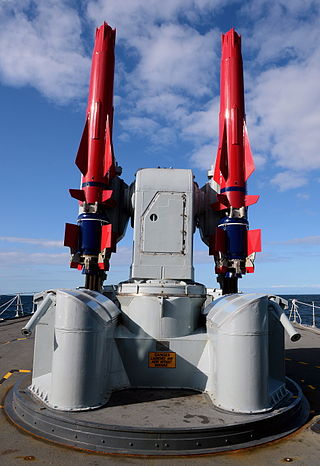
Sea Dart, or GWS.30 was a Royal Navy surface-to-air missile system designed in the 1960s and entering service in 1973. It was fitted to the Type 42 destroyers, Type 82 destroyer and Invincible-class aircraft carriers of the Royal Navy. Originally developed by Hawker Siddeley, the missile was built by British Aerospace after 1977. It was withdrawn from service in 2012.

The Blackburn Shark was a carrier-borne torpedo bomber designed and built by the British aviation manufacturer Blackburn Aircraft. It was originally known as the Blackburn T.S.R., standing for torpedo-spotter-reconnaissance, in reference to its intended roles. The Shark was the last of Blackburn's biplane torpedo bombers.
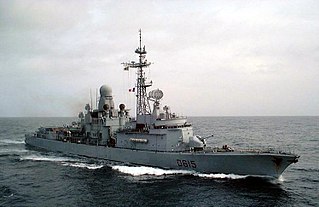
The Cassard class was a class of two anti-air warfare destroyers of the French Navy introduced in the latter 1980s/early 1990s. The class was an air defence variant of the Georges Leygues class. The two classes have a different armament and propulsion system mounted on an identical hull. Their primary role was to provide air cover for a fleet, an aeronaval group, a convoy & a littoral point. Their secondary role was to manage air assets coordination & aircraft control for the force, especially through Link 16.They can also be used for research, identification or presence missions. Both ships were assigned to the Force d'Action Navale. The lead ship of the class, Cassard, was retired in 2019 followed by the retirement of Jean Bart in 2021.

A fast attack craft (FAC) is a small, fast, agile, offensive, often affordable warship armed with anti-ship missiles, gun or torpedoes. FACs are usually operated in close proximity to land as they lack both the seakeeping and all-round defensive capabilities to survive in blue water. The size of the vessel also limits the fuel, stores and water supplies. In size they are usually between 50–800 tonnes and can reach speeds of 25–50 knots (46–93 km/h).
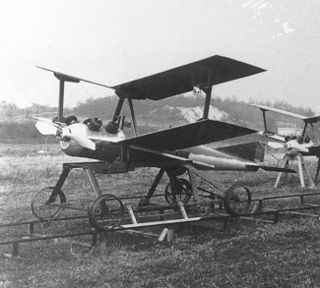
The Kettering Bug was an experimental unmanned aerial torpedo, a forerunner of present-day cruise missiles. It was capable of striking ground targets up to 75 miles (121 km) from its launch point, while traveling at speeds of 50 miles per hour (80 km/h). The Bug's costly design and operation inspired Dr. Henry W. Walden to create a rocket that would allow a pilot to control the rocket after launch with the use of radio waves. The British radio controlled weapons of 1917 were secret at this time. These designs were forerunners of modern-day missiles.

The Avro Type 621 Tutor is a two-seat British radial-engined biplane from the interwar period. It was a simple but rugged basic trainer that was used by the Royal Air Force as well as many other air arms worldwide.
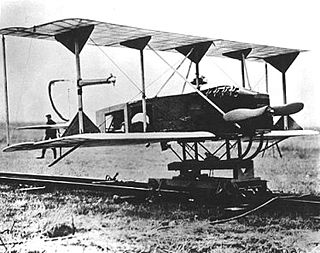
The Hewitt-Sperry Automatic Airplane was a project undertaken during World War I to develop a flying bomb, or pilotless aircraft capable of carrying explosives to its target. It is considered by some to be a precursor of the cruise missile.

An aerial torpedo is a torpedo launched from a torpedo bomber aircraft into the water, after which the weapon propels itself to the target.
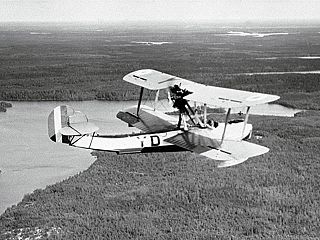
The Canadian Vickers Vedette was the first aircraft designed and built in Canada to meet a specification for Canadian conditions. It was a single-engine biplane flying boat purchased to meet a Royal Canadian Air Force (RCAF) demand for a smaller aircraft than the Vickers Viking with a much greater rate of climb, to be suitable for forestry survey and fire protection work. The type went on to have a long and distinguished career in civil operations in Canada. Most of the topographical maps in use in Canada today are based on photos taken from these aircraft.

The Airspeed AS.30 Queen Wasp was a British pilotless target aircraft built by Airspeed Limited at Portsmouth during the Second World War. Although intended for both Royal Air Force and Royal Navy use, the aircraft never went into series production.
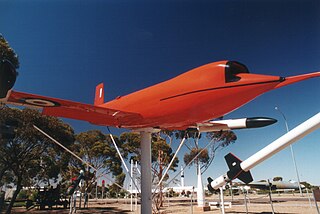
The GAF Jindivik is a radio-controlled target drone produced by the Australian Government Aircraft Factories (GAF). The name is from an Aboriginal Australian word meaning "the hunted one". Two manually-controlled prototypes, were built as the GAF Pika as a proof of concept to test the aerodynamics, engine and radio control systems, serialled A92-1/2, 'B-1/2'. The radio-controlled Jindivik was initially designated the Project B and received serials in the A93 series. Pika is an Aboriginal Australian word meaning flier.

The Canadian Vickers Vanessa was a Canadian biplane transport seaplane of the 1920s. It was a single-engine, twin-float biplane of mixed construction, evaluated by the Royal Canadian Air Force and used for experimental air-mail services..

The Avro Type 584 Avocet was a British single-engined naval fighter prototype, designed and built by Avro. While the Avocet was not built in numbers, one of the prototypes was used as a seaplane trainer for the Royal Air Force's (RAF) High Speed Flight.

The Cierva C.8 was an experimental autogyro built by Juan de la Cierva in England in 1926 in association with Avro. Like Cierva's earlier autogyros, the C.8s were based on existing fixed-wing aircraft fuselages – in this case, the Avro 552.
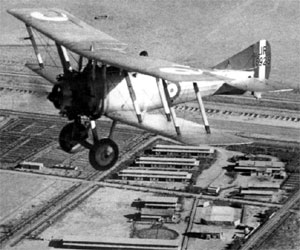
The Nieuport Nighthawk was a British fighter aircraft developed by the Nieuport & General Aircraft company for the Royal Air Force towards the end of the First World War. Although ordered into production before the aircraft first flew, it did not enter large scale service with the RAF owing to unreliable engines. Re-engined aircraft did see service in Greece, serving from 1923 to 1938.
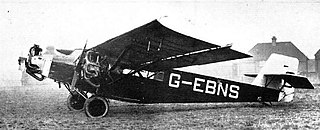
The Handley Page HP.32 Hamlet was a British six-passenger monoplane transport designed and built by Handley Page. Only one was built to order of the Air Ministry, first flown with three-engines, later changed to two then back to three engines.

The Republic SD-3 Snooper was an early reconnaissance drone developed by Republic Aviation for the United States Army. It was evaluated by the Army Signal Corps in 1959, but did not enter operational service.
The Lockheed Aequare was an unmanned aerial vehicle developed by the Lockheed Missiles and Space Company for the United States Air Force. It was intended for launch from an F-4 Phantom II fighter-bomber, and would carry a remote sensor array and laser designator for use by the launching aircraft. The system was evaluated in the mid 1970s, but did not enter operational service.
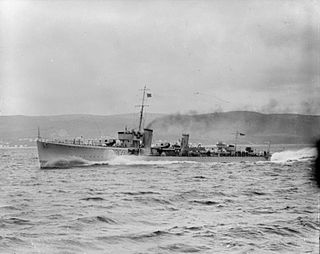
HMS Stronghold was an S-class destroyer, which served with the Royal Navy during the Second World War. The ship was one of the first vehicles to deploy an unmanned aircraft. Launched on 6 May 1919, the destroyer was fitted with a simple catapult in 1924, which used a bag of sand as a weight, and launched the RAE 1921 Target, an early form of unmanned aircraft. A more sophisticated cordite catapult was fitted in 1927 and used to launch the more advanced RAE Larynx. In total, more than twenty test flights were undertaken before the catapult was removed. The destroyer was subsequently fitted out as a minelayer. At the start of the Second World War, the destroyer was based in Singapore. Stronghold helped to rescue the Supermarine Walrus from the battlecruiser Repulse, which had been sunk by the Japanese, in 1941 and, the following year, towed the destroyer Vendetta on the first part of the Royal Australian Navy vessel's journey to Fremantle. On 2 March 1942, the vessel was spotted by a Japanese reconnaissance seaplane and attacked by the heavy cruiser Maya, along with the two escorting destroyers Arashi and Nowaki. Heavily outgunned, the destroyer was sunk with the loss of nine officers and sixty-one ratings.
The RAF began work on a true "flying bomb" in September 1925. Compared with the RAE 1921 Target missile, the Larynx (Long Range Gun with Lynx Engine) was smaller, heavier, and faster. In fact, a 200 hp (150 kW) Lynx IV engine gave the device a top speed of about 200 mph (322 km/h), making it faster than contemporary fighters.